The Complete Guide to Training Your Vizsla Puppy
Have you recently gotten a new Vizsla puppy? Or perhaps you’re in the consideration stages of which dog breed to get? Whatever the case may be, it’s vital that you know what to expect from the breed and how to care for your new bundle of joy.
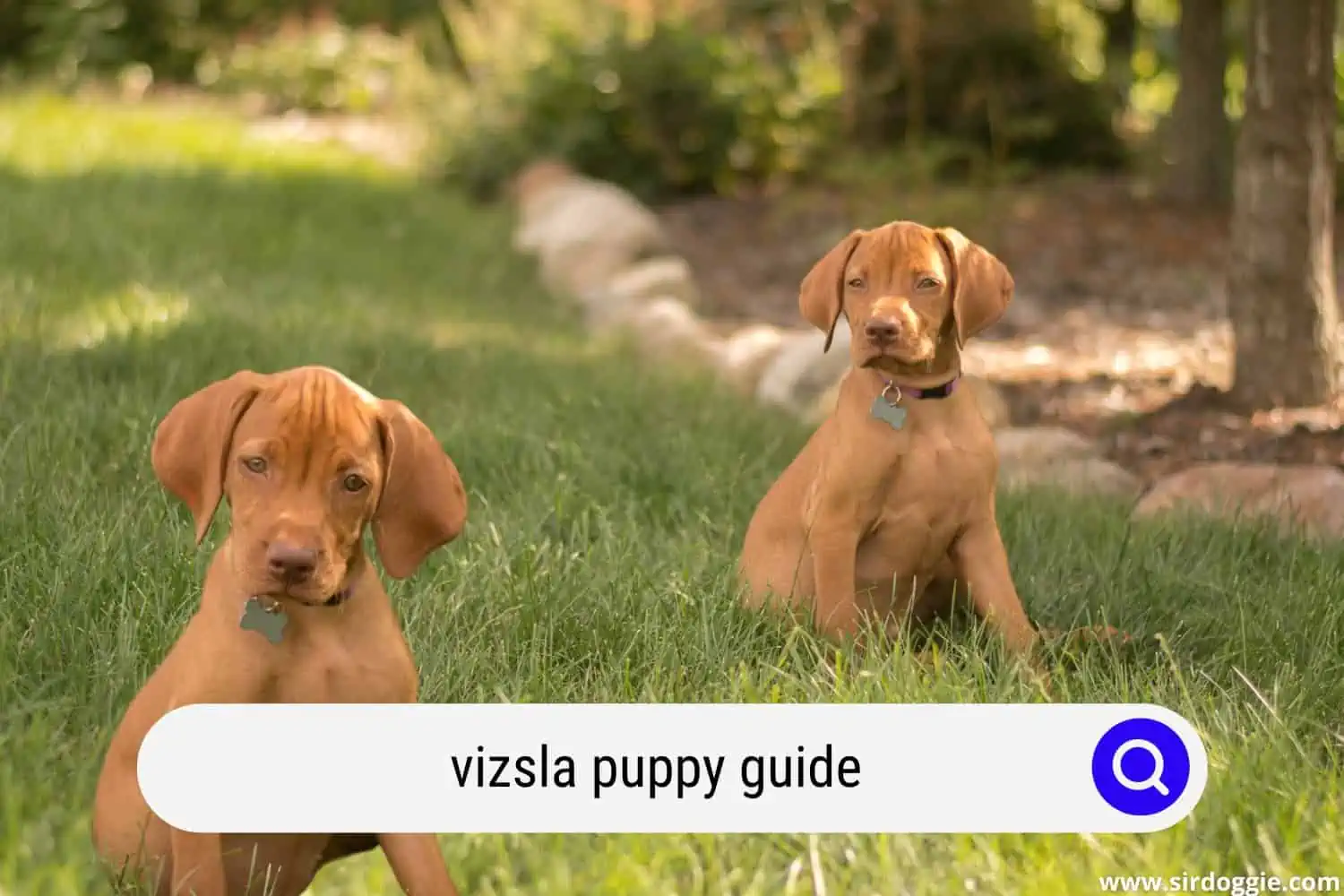
Thankfully, you’ve found us! We’re going to go through everything you need to know about this beautiful breed. From characteristics, to care, to training, you may as well call yourself an expert afterward!
So, hopefully, this training guide will help you out with your Vizlsa puppy!
the History of the vizsla dog breed
The Vizsla breed can be traced back farther than 1,000 years ago. Sometimes, people call this dog the Hungarian Pointer since researchers have concluded that they were used as hunting dogs by the Magyars (people who settled in Hungary).
Vizsla dogs were likely used by royalty to hunt games and fowl. Over time, Vizslas were trained to both point and retrieve, hence their other name.
Of course, no one can be 100% sure that this breed did exist back then. However, an etching created in the 10th century depicts a very Vizsla-esque dog picture. Plus, a script from the 14th century mentions this type of dog too.
Sadly, World War I and then the aftermath of World War II saw the breed become almost extinct. Luckily, the breed did manage to survive and was imported to the United States of America in the 1950s.
Evolution has seen quite a dramatic change in the usual Vizsla appearance. Originally, they had a bonier head, long muzzles, and incredibly elongated ears. Today, as we’ll discuss later on, they look much different.
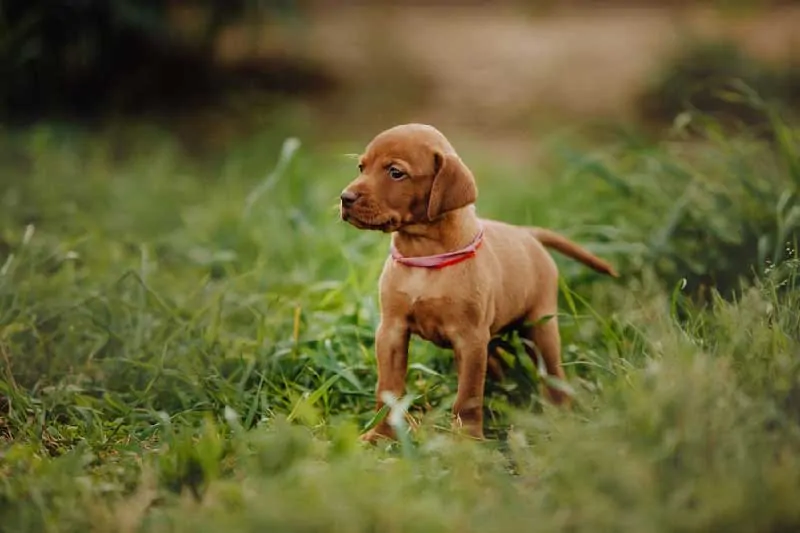
Interestingly, it wasn’t until 1960 that the American Kennel Club formally recognized the breed. But nowadays, they rank 43rd on the American Kennel Club’s list of recognized breeds. They aren’t supremely popular but they are very much loved. In fact, some of them worked on the scene of the terrorist attacks of September 11, 2001.
The Characteristics, Personality, and Temperament of The Vizsla Dog Breed
While each Vizsla dog is different, there is a certain set of characteristics that are used to define the general look, behavior, and personality exhibited by the Vizsla breed.
To familiarize yourself with all of this, take a look at the tables below before moving on to a more in-depth discussion about these loveable creatures.
The General Vizsla Overview
| Size | Large |
| Height | Between 53 and 64 cm |
| Weight | Between 20 to 30 kg |
| Lifespan | More than 12 years |
| Minimum Daily Exercise | 2 hours |
| Coat Length | Short |
| Average Monthly Minimum Cost | $111/£80 |
| Breed Group | Sporting |
Vizsla Health, Physical, and Grooming Stats
| Characteristic | Rating |
| Shedding Amount | 2/5 |
| Potential for Drooling | 1/5 |
| Grooming Ease | 5/5 |
| Overall Health | 4/5 |
| Weight Gain Potential | 2/5 |
| Energy Level | 5/5 |
| Exercise Needs | 5/5 |
| Playfulness | 5/5 |
Vizsla Friendliness and adaptability
| Characteristic | Rating |
| Apartment Living Adaptability | 1/5 |
| For Novice Owners | 3/5 |
| Sensitivity | 5/5 |
| Puts Up With Being Alone | 1/5 |
| Puts Up With the Cold | 1/5 |
| Puts Up With the Heat | 4/5 |
| Family Affectionate | 5/5 |
| Dog Friendly | 5/5 |
| Child Friendly | 5/5 |
| Stranger Friendly | 5/5 |
Vizsla Trainability
| Characteristic | Rating |
| Training Ease | 5/5 |
| Intelligence Level | 4/5 |
| Mouthiness Potential | 4/5 |
| Bark or Howl Tendency | 5/5 |
| Wanderlust Potential | 5/5 |
| Drive for Prey | 2/5 |
The Vizsla breed is widely known for its loyalty, boundless energy, pointing capabilities, and intelligence level. These dogs are incredibly friendly with absolutely everyone and are fantastic for those of you who are active and have gardens.
To tell you the truth, it is hard to keep up with a Vizsla so you’ll need to be on the ball and up for a lot of running around. They love being busy.
The breed craves attention and exercise. Because of this, they can’t be left alone for too long. Otherwise, they will start howling and breaking things out of frustration.
Vizslas will thoroughly love you. They quickly become attached to the whole family so will undoubtedly want to sleep right next to you.
It’s worth remembering that they can’t be left outside. At all. Why? Because they are extremely sensitive to the cold and despise the feeling of solitude. They’ll quickly rip up your garden if you do.
So, Who Are Vizsla Puppies Perfect For?
After all that, you’re probably wondering who the perfect Vizsla companion is, right? Well, if you and your family love getting out and about, a Vizsla puppy is right for you. They’re active and unapologetically friendly. There certainly won’t ever be a dull moment with this pooch!
Common Health Problems in Vizsla Puppies
Unfortunately, like the majority of purebred dogs, Vizslas are prone to some health conditions.
You must ensure the parents of any Vizsla puppy you’re thinking of buying have been regularly health screened. This reduces your chances of purchasing a pup with unexpected issues.
Our advice is to always look for a Kennel Club Assured Breeder. These people have to meet specific requirements in order to maintain their registration, all of which ensure you’re buying a healthy pooch.
Now, let’s take a look at some of the conditions Vizslas have been known to develop:
- Epilepsy — This can’t be cured but the seizures can be controlled with the right medication. Epilepsy doesn’t necessarily shorten the dog’s lifespan.
- Canine Hip Dysplasia — Generally, this is inherited from the parents. It comes about due to the improper fit of the thighbone in the hip joint. A dog with hip dysplasia will often show signs of lameness on at least one of its back legs. Arthritis often develops as the dog ages which can cause them further pain.
- Lymphosarcoma — This is one of the most common cancers in canines. It can affect the spleen, lymph nodes, livers, gastrointestinal tract, and bone marrow. Roughly 80% of dogs go into remission after chemotherapy.
To minimize the risk of your Vizsla puppy having these conditions keep the following in mind when you’re choosing a purchase place:
- Have the puppy’s parents been tested to ensure they don’t have any inheritable conditions?
- Ensure the breeder has the welfare of the litter at heart.
- Ask questions about the health of the puppy.
Caring For and Training Your Vizsla Puppy
As you already know by now, Vizsla dogs have a lot of energy and are very sociable. Therefore, exercise is a huge part of providing proper care for your pup.
They need at least two hours of exercise every day but you don’t have to stick to the same old things. You can try walks, runs, fetch games, canine sports, and/or professional dog therapy work. A lack of exercise causes Vizslas to become hard to handle and pretty destructive so it’s always good to have a runaround.
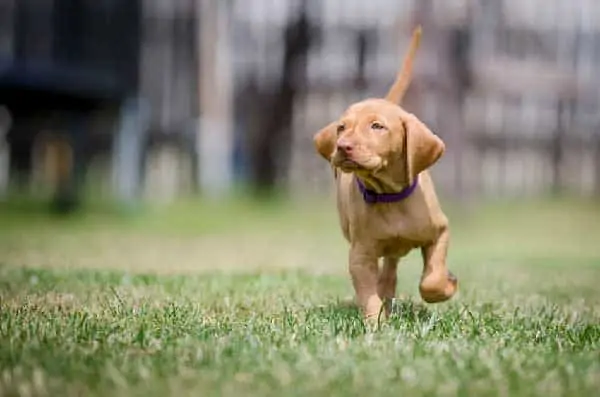
Remember that this breed is incredibly people-oriented so he/she can’t be left outside. You’ll need to be comfortable with having a very close canine companion at most times.
Since these dogs were originally bred for pointing and retrieving, they do have a tendency to chew things. To combat this, play many games of fetch and rotate their toys regularly. Otherwise, they’ll quickly become bored of the same thing and start targeting your furniture or clothing instead!
Let’s Talk Vizsla Puppy Training
Remember when we said that Vizslas are intelligent? Well, they are! However, they typically mature much slower than other dog breeds. Not to mention that they can have pretty short attention spans so training will require a lot of patience on your behalf.
The trick is to socialize them and start obedience training as early as possible. Nine times out of ten, this will need to continue for up to two years (a relatively long time when compared with other breeds).
Having said that, your Vizsla puppy will want to please you. So, while you will need patience and a bunch of effort, training will become a joyful experience.
We figured we’d give you some tips and tricks to keep in mind when training this sometimes fiery but ever so loving pup breed.
Work Through The Extended Puppy Phase
Two years of at-home training alongside puppy classes will give you the best chance of working through their mischievous tendencies.
We encourage you to push through the typically elongated puppy phase because it will absolutely be worth it. Your Vizsla is bound to be an extremely smart pooch who will love learning throughout their whole life.
At the end of the day, they are made for work. They want to please you and work hard to pick up the skills you’re trying to teach them. You just need to persevere!
Start Early
Even though Vizslas are famously slow at maturing, it’s still best to start your training early. Waiting will only cause awful situations to develop.
Don’t get us wrong — it’s likely to be a trying time. However, it’s a must to bring up a well-rounded pup.
Use Training to channel energy
This dog breed tends to do very well at dog agility. It’s a fabulous mix of exercise and training that can use all of that energy as a positive thing rather than getting in the way of constantly distracting them.
To put it simply, they need both their body and mind occupied to live a long and happy life.
Use Positive Reinforcement
Vizslas are sensitive and they don’t respond well to harsh or negative reactions/training. Instead, you will need to use a positive-only protocol.
If your pooch isn’t getting something right, don’t punish him/her. Instead, praise them when they get it right. This way, they are more likely to want to please you and work on their skills.
Before You Get a Vizsla Puppy, Have The Time
All puppies require a lot of work. However, Vizslas are one of the most high-maintenance breeds because they require a lot of time, attention, and patience.
Training is one of the most time-consuming activities since their maturity period is very long. But even after that, you’ll need to be able to dedicate a significant amount of time to ensuring your furry friend exercises and plays enough.
Feeding Your Vizsla Puppy
Feeding your Vizsla a complete, balanced diet is vital to ensuring they stay healthy and slim. However, the specific food type and quantity you give will depend on their age and other factors.
A good-quality breeder will advise you as to the food they were eating before your purchase and how much they’re used to. However, you should always check with your vet and take their advice. After all, they will not only know about your dog’s breed but also your specific pup.

Ideally, you need to be feeding your dog a top-class complete dog food that is widely available in supermarkets. Some new puppy parents try to make their own but it’s near-on impossible to give them all the nutrients they need this way.
Generally speaking, Vizslas should be eating 3 to 4 cups of dog food each day. This should be divided into two meals. However, it’s important to remember that all dogs are different — even if they’re the same breed. It’s important to consistently measure their food to ensure they remain in good shape.
If you’re going to be using treats as training aids, you should keep track of how many you’re feeding them so you can subtract this from their daily allowance. An overweight (or underweight, of course) Vizsla, is an unhappy Vizsla.
How to Check If Your Vizsla Puppy Is Overweight
For those of you who aren’t sure whether your Vizsla is overweight, you can do the eye and hand test.
Eye Test
- Stand over your dog.
- Look down at them.
- You need to see a waist.
Hand Test
- Put your hands on your dog’s back.
- If you can’t feel his/her ribs or see a waist then your Vizsla needs more exercise and less food.
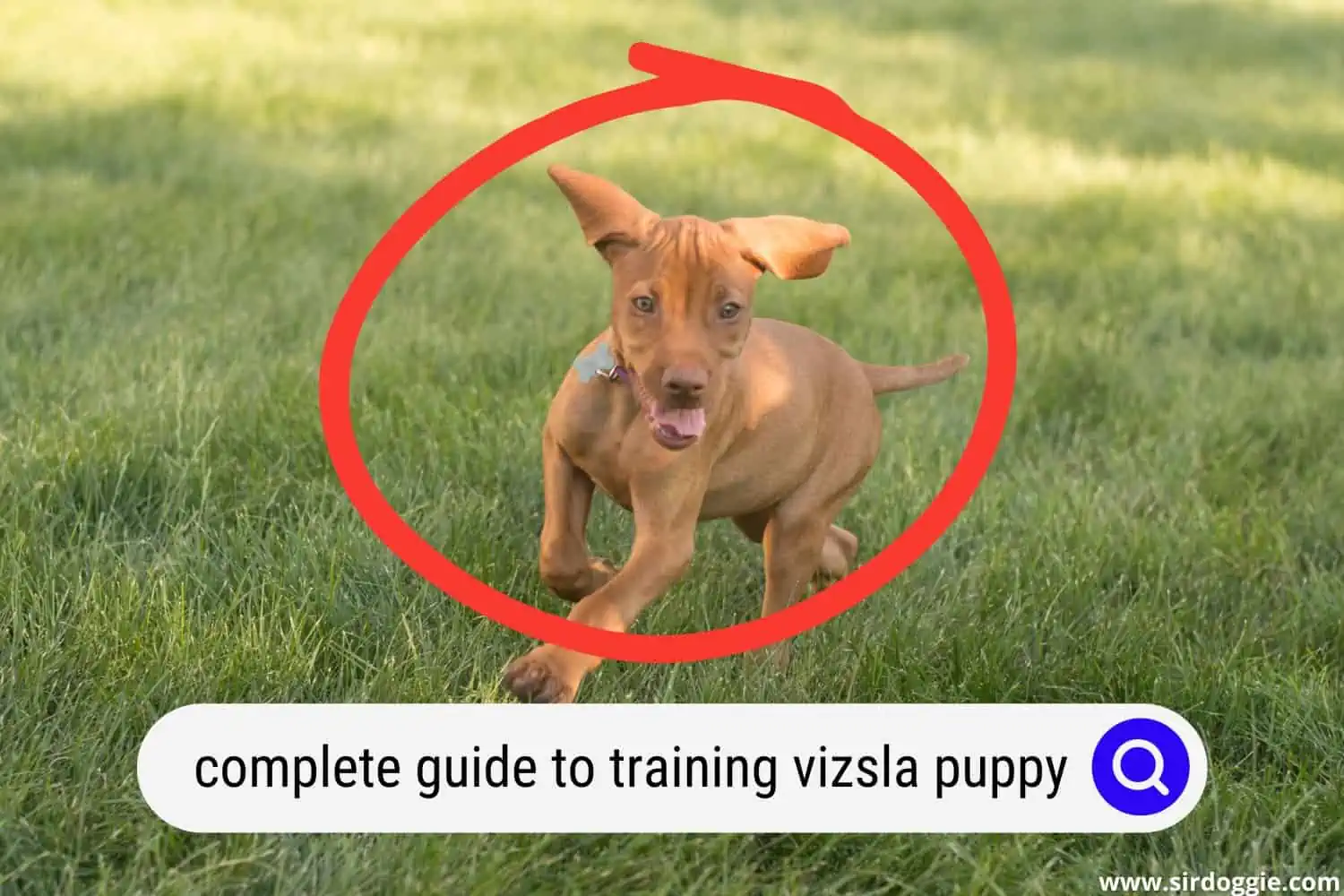
Everything You Need to Know About The Vizsla Coat
Vizslas come in all shades of gold-rust and tend to have a smooth, incredibly short coat. It sits very near to the body, making grooming a breeze.
How to Groom Your Vizsla Puppy
Grooming your Vizsla’s coat is a pretty simple process. All that’s needed is a rubber curry brush and then a damp cloth to wipe them down. This should be done about once a week to get rid of any loose hair that will build up throughout the week.
Thankfully, they don’t really need to be bathed that often, so you won’t have that constant smell of wet dogs in the air!
As for their claws, you should aim to trim them at least once per month. Sometimes, they’ll need them to cut extra time but that’s up to you.
A good rule of thumb is this — if you hear them on the floor, they need cutting.
Grooming Tips and Tricks
You should begin brushing your pooch when they are a puppy to give them the best chance at liking it as they mature. It’s a good idea to frequently touch their paws, ears, and mouth too so they don’t become frustrated or agitated by this gesture when they grow up.
Ensuring grooming is a positive experience can help make vet examinations as easy as possible.
Vizsla Puppies With Children and Other Pets
While Vizslas are loving and friendly, they can be a bit too overwhelming for children younger than 6 years of age.
You will need to teach them how to play nicely with kids so they don’t start seeing them as competition (or prey!). Depending on how small your little ones are, these hunting-bred pooches can be quite keen on capturing them.
But don’t worry, all of this can be avoided with the right training.
As for other pets, Vizslas tend to be friendly toward other dogs and can get along with cats. However, you’ll need to rethink having smaller animals like birds, gerbils, or hamsters as these dogs tend to love them too much.
Final Thoughts
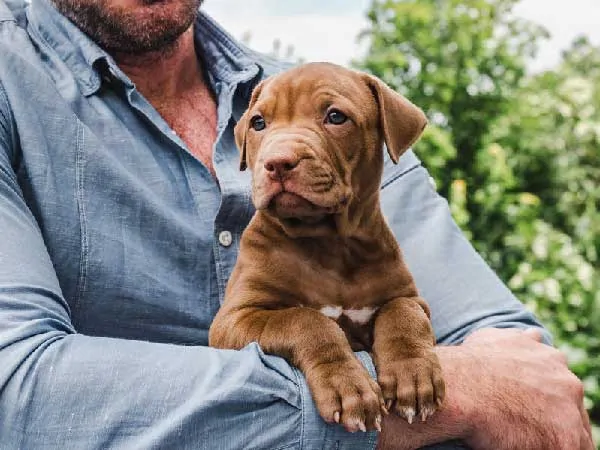
Vizslas are loveable, charming, oh-so-intelligent dogs (despite the extended maturity period). However, you need to be extra sure that you have the time and the space to give them the hours of exercise, love, and attention they require.
If you do, you’re sure to have a permanent companion by your side with a Vizsla.

Family Dog Expert Author
Hi there! I’m Stuart, a devoted dog lover and family dog expert with over a decade of experience working with our furry companions. My passion for dogs drives me to share my knowledge and expertise, helping families build strong, loving bonds with their four-legged friends. When I’m not writing for SirDoggie, you’ll find me hiking, playing with my beautiful dog, or studying music.